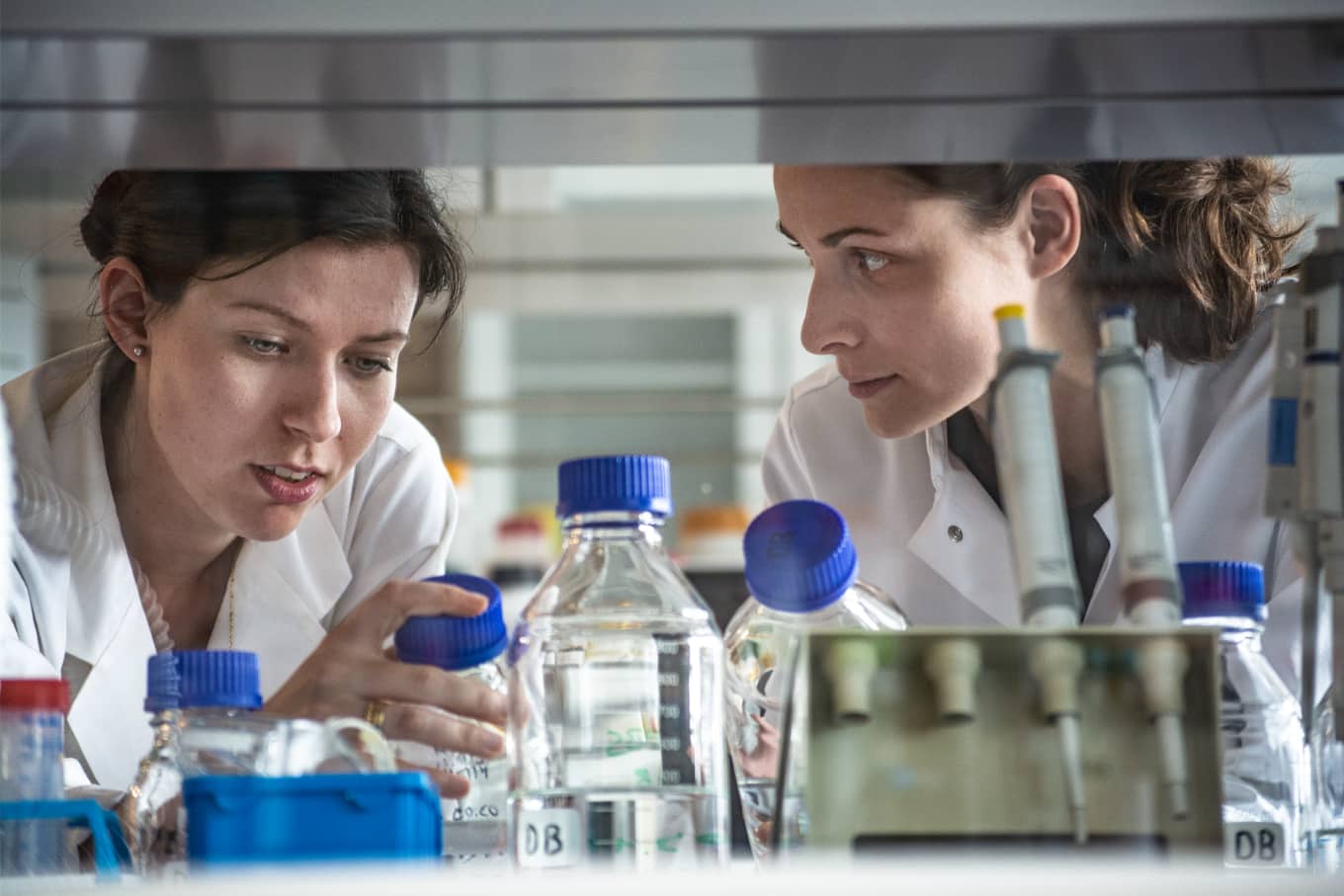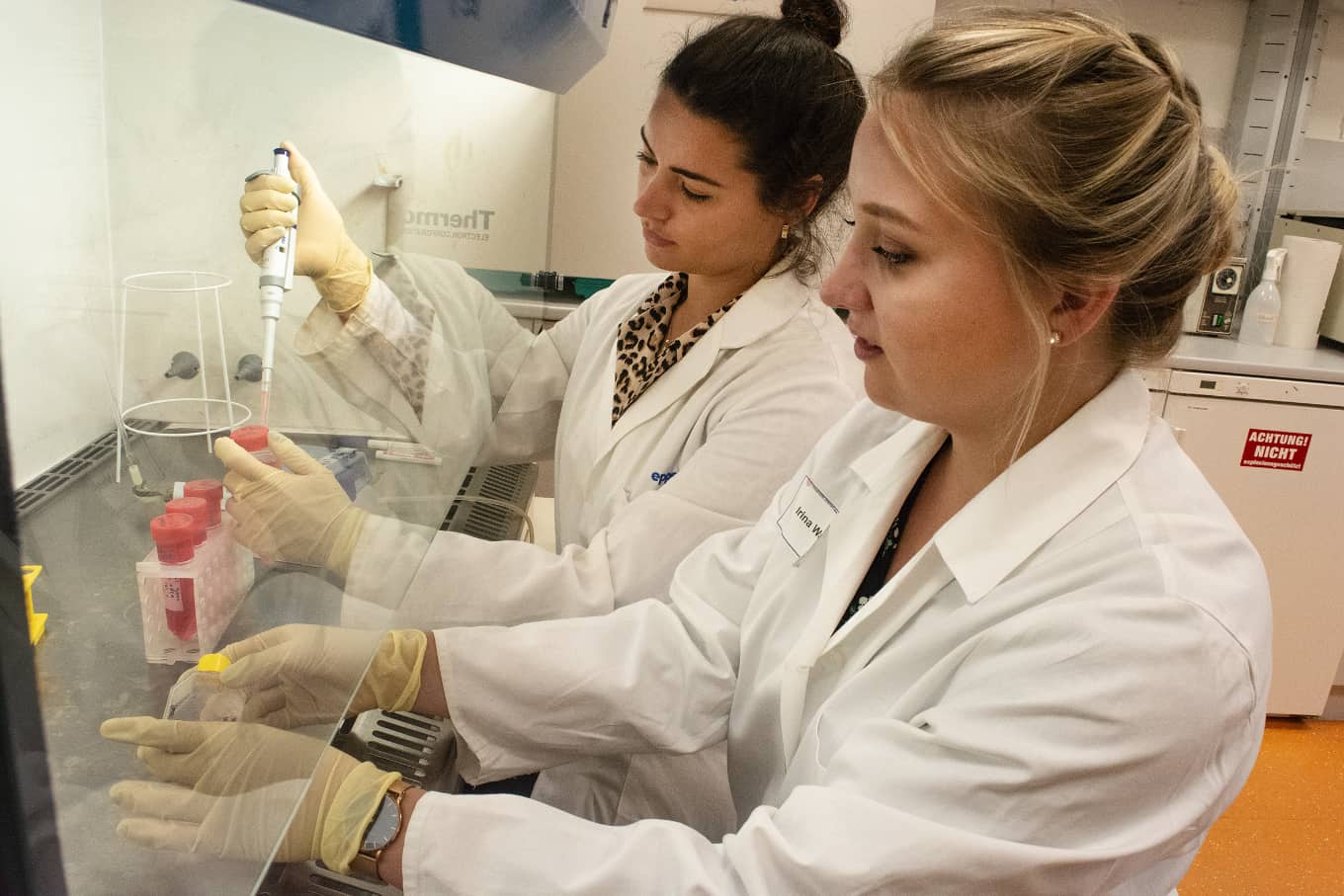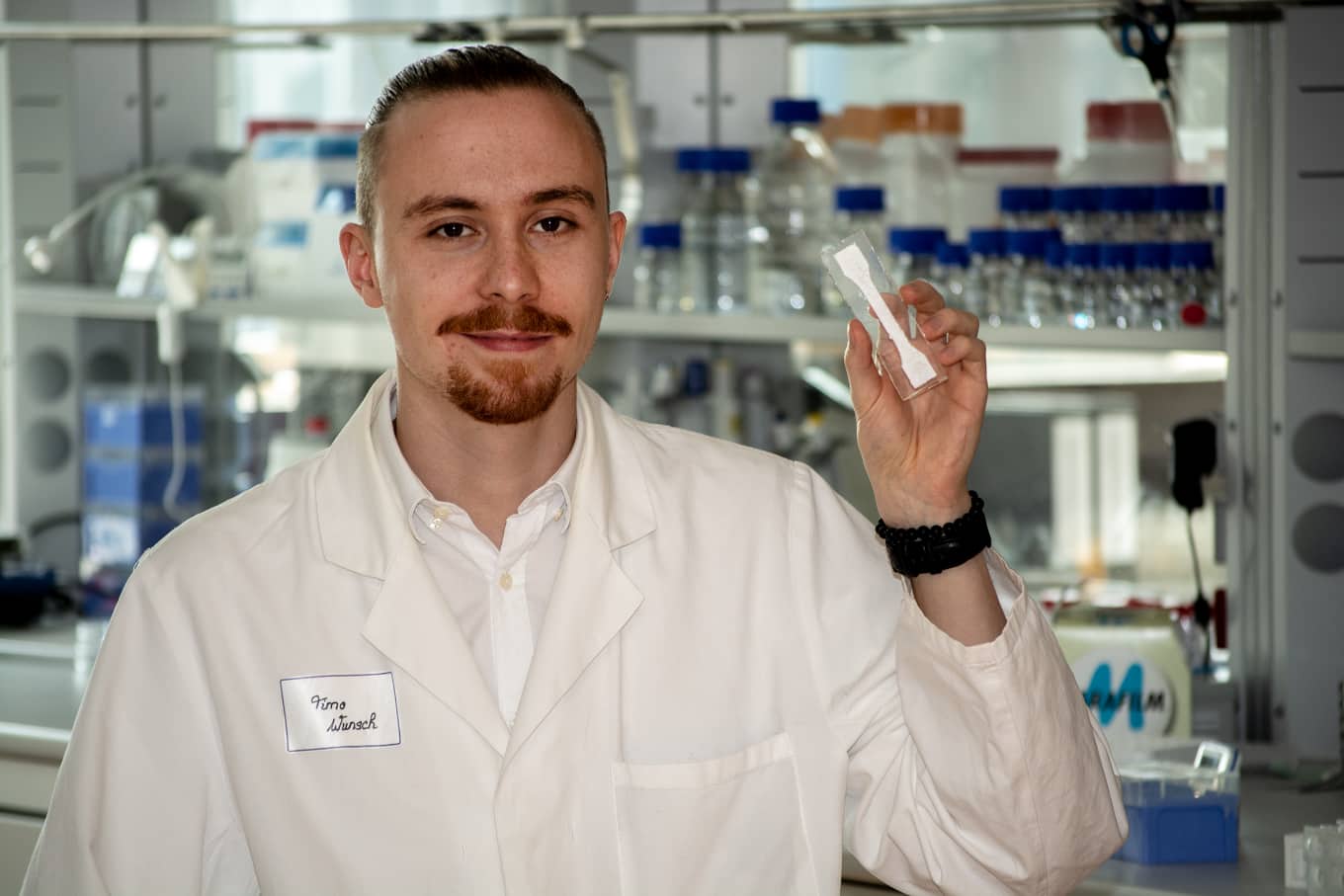Nanoscaffolds for the Medicine of the Future
Biophysicist Professor Dorothea Brüggemann and her research group are developing new materials for use in the human body
Wound plasters made from the body’s own proteins or biological coatings on implants that facilitate in-growth in the body – one day, all of these things will exist. When it comes to fundamental research for applications of this kind, sometimes coincidences can be helpful at the interface where biology and physics meet. As was the case of doctoral student Karsten Stapelfeldt, who suddenly discovered nanofibers in places he did not expect to find them while performing tests with a scanning electron microscope. Together with colleagues, he started searching for correlations – with sensational results.
“Fiber scaffolds made from natural materials would be an outstanding aid for patients with blood-clotting disorders.”
Professor Dorothea Brüggemann
160 170, 180 cm are normal body heights around the globe. However, when it comes down to the details, humans are infinitesimally small – we are dealing with measurements in the micrometer range on the cellular level. These cells are surrounded by nanostructures, for instance fibers with a size of a few billionths of a meter. “This is where our work begins,” says Dorothea Brüggemann, leader of the Emmy Noether research group for nanoBiomaterials at the Institute for Biophysics, University of Bremen. “We are developing fibrous nanoscaffolds that we want to introduce into the human body and on which cells establish themselves.” These nanomaterials can be fitted with additional functions to help people in various ways.
The best example of the work from Brüggemann’s research group is a three-dimensional protein scaffold with which the researchers have impressed experts. This scaffold, which might one day even be produced using human blood, could then help heal wounds as a kind of ‘biological plaster’. Normally, the human body closes smaller wounds with a crust known as a ‘scab’. “Fibrinogen, a protein found in blood plasma, is converted into fibrin by the enzyme thrombin. The result is the formation of nanofibers,” says Karsten Stapelfeldt, explaining the process. “The resulting tissue, which consists of microscopically small fibers, ensures wound closure in the human body and supports the healing process. We have produced a biologically inspired fibrinogen network of this type in the laboratory without adding enzymes.” In the meantime, with the help of Bremen patent utilization agency InnoWi GmbH, a European patent application has been submitted. The discovery has great potential for the future.

Material from Your Own Blood
“Normally, when people have wounds they use plasters and dressings that also function as a wound cover –a synthetic one,” Dorothea Brüggemann points out. “In the future, the usage of the body’s own fibrinogen could enable the production of a bioresorbable wound dressing that can slowly be absorbed by the body. Our vision: Some day, every person will be able to have their ‘own biological plaster’ that will be perfectly accepted by their body.” She imagines a future where “people will perhaps have some blood taken in their infancy stages in order for their body’s own material to be stored for such applications.”
Using the scanning electron microscope, Karsten Stapelfeldt examined the self-organization process, which forms ultra-fine fibers out of dissolved protein that then connect and create a nanoscaffold. The research group subsequently took a closer look: How are the fibrinogen networks formed? As soon as the mechanism was decoded, they went about producing a layer of natural fibrinogen scaffolding a few micrometers thick that could actually be held in your hand – the first step towards a ‘natural’ wound dressing.

From Small to Big
A “multi-scale approach for the development of biologically inspired fiber scaffolds” is how Dorothea Brüggemann describes the core of her work. “We research and develop on a nano-level, however we also want to understand the underlying atomic and molecular range,” she says. She has been collaborating successfully in this field with the Hybrid Materials Interfaces research group, which is led by the production technician Professor Lucio Colombi Ciacchi. “We want to specifically control and monitor cells that are several micrometers in size with our nanoscaffolds. The scaffolds that we build should then essentially be macroscopically visible, such as the fibrinogen scaffolding to be used as a wound dressing. That’s why it is multi-scale: Understanding of the small things, application in the big things.”
Once the ‘blueprints’ and mechanisms of the natural fiber scaffolds have been researched in detail, many application possibilities are imaginable for multifunctional fiber scaffolds. For instance, if it were possible to integrate medication into the scaffolds, it would then be possible to introduce them as an aid right into specific areas of the body. “Fiber scaffolds made from natural materials would also be an outstanding aid for the blood clotting of patients with blood-clotting disorders, so-called hemophiliacs,” says Dorothea Brüggemann, naming another possible application option.
The Focus Is also on Collagen
Another protein that the research group is focusing on is collagen. It occurs in large amounts in the skin or in blood vessels and is very flexible. “We are using another self-organization process to produce nanofibers from collagen. Additionally, we have developed a procedure where micrometer-sized areas of a material can be precisely coated with collagen nanofibers,” Naiana Suter from the team explains. “Cells can sense whether they are on a fibrous or smooth surface. They grow into fibrous areas, and spread out on smooth surfaces. This allows the development of cell structures to be selectively controlled.” This research result was also registered for patent approval after consultation with InnoWi GmbH. The possible application: “To monitor how an implant is being accepted by the body – particularly as bones also consist of collagen to a large degree.” Since hip implants, for instance, are generally made from titanium and polymers, a coating of this kind would definitely be appropriate: “The cells would then come into contact with protein fibers and not with metal or plastic.”
Another one of the research group’s plans combines the expertise of various fiber scaffolds with ceramic biomaterials. Post-doctoral fellow Dr. Jana Markhoff is investigating how nanofiber scaffolding can be used as a coating for nanoporous ceramics in the MIMENIMA (Micro-, meso- and macroporous nonmetallic Materials) research training group. The goal is to develop new material combinations as biomaterials from it.
Work with “Magnetic Fibers”
If that weren’t enough: Dorothea Brüggemann and her team also work with chitosan, a material that occurs in a similar form in the shells of insects, spiders and crustaceans. “Chitosan can be purchased as a ready-made powder. We make fibers out of it, which we then combine with magnetic nanoparticles in cooperation with PD Dr. Michael Maas from the field of advanced ceramics.” Later, these ‘magnetic fibers’ might even be able to move in the body. The work of the research group is moving in the direction of targeted fiber orientation. “In this way, the direction of cell growth may even be able to be controlled with magnetic fibers externally,” Dorothea Brüggemann, the Emmy Noether Award winner, says.
However, that is a vision of the future. Dorothea Brüggemann’s research group still has a lot of work to do before research results emerge in real applications: “Especially as we are moving in the direction of medical applications, which is an extremely challenging area,” the leader of the research group explains. To begin with, the foundations have to be developed: “Next, we will test how cells react to our fiber networks and how they grow under various conditions. In order to examine the mechanical stability of our new scaffolds, we are also cooperating with the Bionik-Innovations-Centrum B-I-C at the Bremen City University of Applied Sciences.” Small steps instead of big leaps – that is how science works.
Emmy Noether Funding
As part of the Emmy-Noether Program, Dorothea Brüggemann’s research group for nanoBiomaterials is financed with over 1.6 million Euros by the German Research Foundation (DFG). It is intended to give particularly promising junior scientists the opportunity to qualify for a university professorship within six years by leading a junior group. One of the funding requirements is the submission of an excellent research project outline. The program was named after the mathematician Emmy Noether (1882 – 1935).
Profile

“I wish to keep research in the field of wound healing”
26-Yeal-old Timo Wunsch worked in Brüggemann’s working group for his master’s degree
Production engineering with a focus on material sciences – is the master’s degree that Timo Wunsch completed at the University of Bremen. The 26-year old, who previously completed his bachelor’s degree in biomimetics at the Bremen City University of Applied Sciences, worked intensively in Professor Dorothea Brüggemann’s research group for his master thesis. “In producing fiber networks from the blood protein fibrinogen, I performed a mechanical analysis of larger samples. In other words, I determined the resilience of the material and examined its suitability for wound healing.”
He graduated in the late summer of 2019. Now Timo Wunsch is waiting for a funding opportunity to also do his doctorate under the supervision of Dorothea Brüggemann. “The start of 2020 will reveal whether funds will be available. I will use the time up until then to fulfill a dream: I would like to hike the 800 km long Camino de Santiago from Saint-Jean-Pied-de-Port in France to Santiago de Compostela in Spain.”